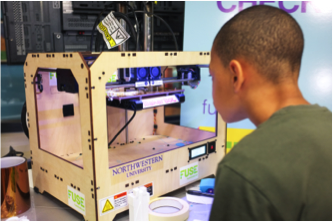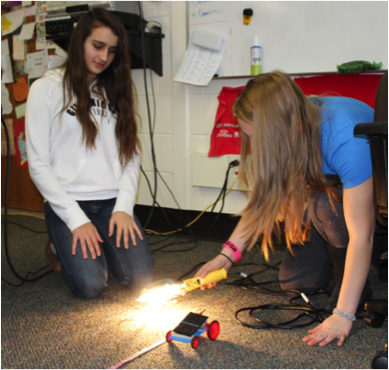FUSE
Introduction to FUSE
The FUSE program engages young people ages 11-18 in science, technology, engineering, arts/design, and math (STEAM) through interest-driven activities in a youth-centric, free-choice environment.
FUSE is designed specifically to engage young people who have not yet identified strong interests in STEAM topics. The project leverages young people’s existing interests in music, design, and pop culture to inspire the development of new interests in STEAM and foster important 21st century skills including adaptive problem solving, creativity, self-directed learning, persistence, and grit.

Primary funding for FUSE is provided by the John D. and Catherine T. MacArthur Foundation and the National Science Foundation under NSF grant DRL-1348800. The design team is led by Dr. Kemi Jona and Dr. Reed Stevens of the School of Education and Social Policy at Northwestern University. Through FUSE, teens can “hang out, mess around and geek out” with the FUSE set of challenges, the core activities in our Studios. Each challenge uses a leveling-up model from gaming and is carefully designed to engage teens in different STEAM topics and skills sets. FUSE currently has 21 challenges in areas such as 3D printing, robotics, electronics, fashion design, biotechnology, graphic design, Android app development, and more. New challenges are always in development.
At FUSE, young people can choose which challenges they wish to work on and how long they want to stick with it before trying something new. Each challenge can be tackled individually or with a group of friends. All challenges result in digital media artifacts that are shared online for peer review, remixing, expert judging, and collaboration.
Research Background for FUSE
Inspiration for FUSE comes from previous research done by our PIs, as well as other researchers in the field. Dr. Stevens is a co-lead on the NSF-funded LIFE Center, which studies STEM-related learning outside of schools and the possible design implications of these out-of-school learning experiences for innovations in the design of new learning environments. A second line of research informing our work comes from the Digital Youth Project (Ito et al., 2009), which involved examining how youth engage in learning with new media and what roles adults play in those experiences. The Digital Youth Project emphasized the power of ‘connected learning’ (Thomas & Brown, 2011), which was characterized as participatory, learner-centered, interest-driven, and inclusive. Ito et al. (2009) identified three phases of youth engagement: hanging out, messing around, and geeking out. As a young person gains interest and expertise in a topic, he or she moves through these phases: Hanging Out (HO), a primarily friendship-driven exploratory stage; Messing Around (MA), interest-driven experimenting and playing with ideas; and Geeking Out (GO), developing an identification with a topic and a commitment to acquiring further expertise. FUSE is designed to engage teens in the Hanging Out and Messing Around stages, with the goal of helping young people connect to "Geeking Out" opportunities outside of FUSE once they choose to pursue their new interests more deeply through tools embedded on our website, fusestudio.net.
A third inspiration for FUSE comes from the YOUmedia space at the Harold Washington Library in Chicago, IL. YOUmedia (http://youmediachicago.org/) is an innovative space for high school-age youth to explore, create, and learn with various forms of digital media (Sebring et al, 2013). Similar to prior after-school sites like the Intel Computer Clubhouse Network (Resnick, Rusk, & Cooke, 1998), YOUmedia was created to connect Chicago youth to digital media production tools and mentors. Our efforts seek to enable similar access in the area of STEAM.
Implementation and Progress
FUSE launched as an afterschool program in April 2012 at three Chicago area high schools. Since then, twenty-three different schools and libraries have adopted FUSE, reaching nearly 2,000 young people. With this growth, the diversity of ways that our partners are implementing FUSE has also increased. While FUSE is still offered after school at some locations, a growing number Studios run as part of the regular school day, embedded within specific courses, or even as part of a summer camp. This adaptability, combined with low implementation costs, has made FUSE a popular choice for organizations looking to offer new types of STEAM programming to their youth.

Youth engage with FUSE challenges through our custom online learning platform, www.fusestudio.net. To advance through the levels of each challenge sequence, users upload digital artifacts—such as photos, videos, or 3D design files—to document their completion and “level up.” Along the way, youth can access a suite of video tutorials carefully designed to answer the most commonly asked questions for each level in an “on-demand” fashion, as they need it. This allows FUSE Facilitators, who are usually teachers or librarians from our partner organizations, to act as problem solving coaches and mentors instead of feeling pressure to have all the correct content specific answers.
Each young person at FUSE has a unique account on fusestudio.net that tracks their levels attempts, completions, and stores their uploaded artifacts in an online portfolio. The FUSE team uses these data to measure how many youth are starting the challenges, and how many levels of each challenge they persist through. For a free-choice environment like FUSE, it is imperative that the challenges we develop are fun and appealing to a wide range of teen interests. As challenge designers, we take the engagement data produced by our website to heart and we continue to revise challenges until they have broad appeal and youth are successfully leveling-up through each sequence. “Often people think of equity that we want the same thing for all students,” notes Dr. Jona, “and I actually think that when you look at it through the connected learning lens, and you take the idea of interest-driven learning seriously, then you quickly realize that equity doesn’t mean the same thing for all kids, it means taking all kids interests equally seriously.”
FUSE works with a diverse range of partners to design challenges that combine cutting edge technology and the interests of young people. To date, challenge design partners have included Motorola Mobility, Siemens, the Chicago Architecture Foundation, and local jewelry designer Christopher Duquet. The full list is updated regularly on the FUSE site.
Evaluation
Close analysis of our user data ensures that we are addressing the interests of girls and minorities who are typically underrepresented in STEM fields. Some challenges, such as Jewelry Designer, and Design your Line, were developed specifically with young girls in mind, but we are also careful to design gender-neutral challenges that will still appeal to girls, such as Eye Candy (designing 3D-printable eyeglasses) and Just Bead It, a biotechnology challenge.

Other research initiatives at FUSE seek to understand how interest-driven experiences such as our set of challenges promote the development of 21st-century skills like adaptive problem solving, creativity, persistence, and grit. In situ observations, video data, and informal interviews reveal stories of FUSE youth who are becoming more strategic problem solvers, and who are less afraid of failure. “I think that I’ve gotten better at adapting to changes,” one teen commented. “Like, when something goes wrong, I’ve been able to just deal with it easier. In the beginning, that didn’t really happen , but like, a couple weeks ago, when the whole file was all messed up, I just didn’t care and started over.” This idea that it’s OK when things don’t go according to plan the first time, that failure is “just another try,” is one of the core messages for young people at FUSE.
In addition to our own internal program evaluation via website and video data and observations, an external review team of learning sciences experts is evaluating the impacts of FUSE on youth.
Future Plans
Our next steps are two-fold. FUSE will be opening 3 new Studios this summer and several more at the beginning of the 2014-2015 school year. We will be continuing to open Studios as our capacity allows, and we’re always interested in hearing from potential new partners.
To keep pace with the diverse interests of our youth population, we also continue to seek new challenge design partners. If you’re interested in sharing your STEAM expertise by designing a FUSE challenge, we’d love to hear from you.
References
Ito, M. (2009). Hanging Out, Messing Around, and Geeking Out. Massachusetts: MIT Press.
Thomas, D. & Brown, J. (2011). A New Culture of Learning: Cultivating the Imagination for a World of Constant Change.
Resnick, M., Rusk, N., & Cooke, S. (1998). The Computer Clubhouse: Technological Fluency in the Inner City. In Schon, D., Sanyal, B., & Mitchell, W. (Eds.) High Technology and Low-Income Communities. Massachusetts: MIT Press. Retrieved from http://web.media.mit.edu/~mres/papers/clubhouse-chapter.pdf
Sebring, P., Brown, E., Julian, K., Ehrlich, S., Sporte, S., Bradley, E. & Meyer, L. Teens, Digital Media, and the Chicago Public Library. Chicago: UChicago CCSR. Retrieved from http://ccsr.uchicago.edu/sites/default/files/publications/YOUmedia%20Report%20-%20Final.pdf